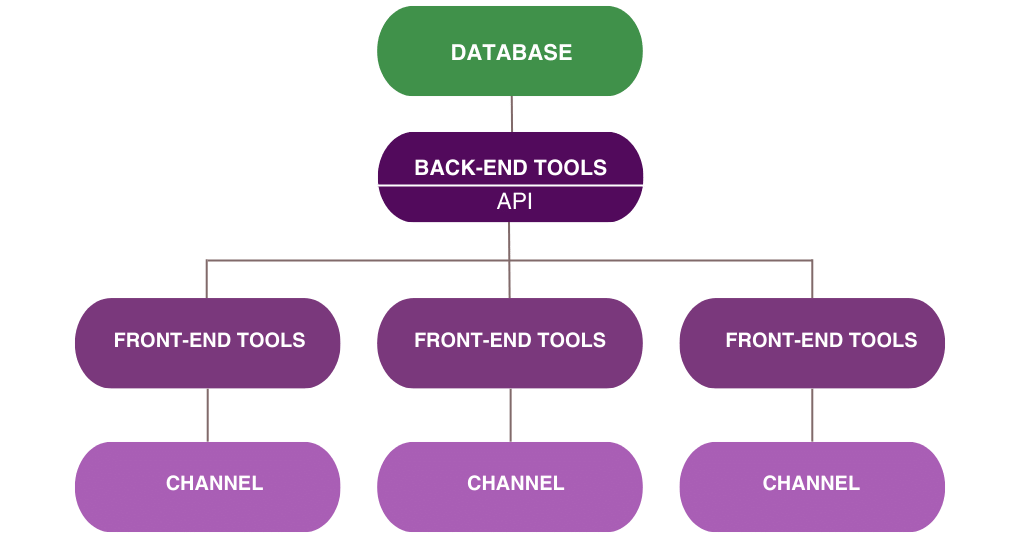Salesforce Commerce Cloud is a cloud-based platform that enables businesses to create personalized and seamless shopping experiences across all digital channels. For modern retailers, this platform provides a wide range of tools and features to effectively manage eCommerce operations, including product merchandising, mobile optimization, AI-powered personalization, and integration with other Salesforce products such as Sales Cloud and Service Cloud. It also offers comprehensive analytics and reporting capabilities, providing valuable insights into customer behavior, sales performance, and marketing effectiveness. Simply put, Salesforce Commerce Cloud provides tailored solutions for B2B and B2C customers to drive sales and build long-lasting relationships.
In this guide, we will look into the following aspects:
- Role of Commerce Cloud in Revolutionizing the Retail Industry
- Benefits of Commerce Cloud
- Use case of Headless Commerce and Commerce Cloud Implementation
Drive exceptional growth in B2B and B2C commerce with our tailored solutions.
Role of Salesforce Commerce Cloud in Revolutionizing the Retail Industry
Salesforce Commerce Cloud plays a crucial role in revolutionizing the retail industry in the following ways:
1. Tracks and Manages Products at Every Stage of the Retail Cycle
Salesforce Commerce Cloud effectively tracks and manages products at every stage of the retail cycle, ensuring seamless inventory management and improved operational efficiency. For instance, its inventory tracking capabilities enable retailers to monitor stock levels in real time, anticipate demand, and optimize product availability. This not only minimizes the risk of overstocking or stockouts but also enhances the overall supply chain management process.
2. Unified Customer Experiences Across Channels
With Commerce Cloud, retailers are equipped to deliver unified customer experiences across multiple channels, such as online stores, mobile apps, and physical retail locations. An example of this is its omnichannel capabilities, which enable customers to transition between online and offline shopping experiences. By providing a consistent and personalized experience across various touchpoints, retailers can ensure customer loyalty and drive engagement.
3. Improved Inventory Management
Salesforce Commerce Cloud’s advanced inventory management features have significantly improved the way retailers handle their inventory. For instance, its predictive analytics capabilities help retailers forecast demand more accurately, optimize stock levels, and reduce carrying costs. Moreover, by integrating with other enterprise systems, such as enterprise resource planning (ERP) platforms, Salesforce Commerce Cloud facilitates streamlined inventory replenishment and procurement processes, leading to cost savings and operational efficiency gains.
4. Consistent Upgrades to Stay Relevant in the Retail Industry
Consistently upgrading technology, processes, and customer experiences is crucial to meet the changing demands of consumers in today’s hypercompetitive retail industry. This is where Commerce Cloud plays a vital role by helping retailers stay relevant. For example, implementing new point-of-sale systems, integrating mobile payment options, and adopting innovative inventory management solutions are all ways in which retailers can stay ahead of the curve.
5. Optimization of Supply Chains for Demand and Margin
Optimizing supply chains involves strategically managing the flow of goods and services to meet customer demand while maximizing profit margins. This can be achieved through the use of advanced forecasting and inventory management tools. For instance, using data analytics to predict demand patterns and adjust inventory levels accordingly can help minimize stockouts and reduce excess inventory, ultimately improving both customer satisfaction and profitability.
6. Automated Analysis Dashboard
An automated analysis dashboard provides real-time insights into various aspects of retail operations, such as sales performance, inventory levels, and customer behavior. For instance, a retail company can use an automated analysis dashboard to track sales trends by region, identify top-selling products, and monitor customer feedback. This allows for data-driven decision-making and the ability to quickly respond to changing market conditions.
What are the Benefits of Commerce Cloud for Modern Retailers?
There are various advantages of Salesforce Commerce Cloud for modern retailers, some of which have been discussed below:
1. Website Creation and Optimization
Commerce Cloud’s Page Designer Feature provides modern retailers the tools and resources to create, customize, and optimize their websites. This allows retailers to maintain control over their online presence and tailor their website to their specific branding and customer needs. A retailer can easily set up an online store with personalized branding, product categories, and shopping cart features within the Commerce Cloud platform.
2. Unified Shopping Experience for Enhanced Customer Experience
Commerce Cloud offers a unified shopping experience across all channels, including online, mobile, and in-store. This means that customers can have a consistent and seamless experience whether browsing products on a website, using a mobile app, or visiting a physical store. For instance, a customer can start shopping on a retailer’s mobile app and later continue the purchase on the website without disrupting the shopping experience.
3. Highly Scalable Platform
One of the key benefits of Commerce Cloud is its highly scalable nature. Modern retailers can easily expand their online operations as their business grows without worrying about infrastructure limitations. For instance, a retailer experiencing a surge in online traffic during peak seasons, such as Black Friday, can rely on Commerce Cloud to handle the increased load without service disruptions.
4. Centralized Platform for Marketing
As a cloud-based platform, Commerce Cloud provides retailers a centralized platform for managing marketing activities. This includes tools for email marketing, social media integrations, and personalized marketing campaigns. By leveraging these capabilities, retailers can use Commerce Cloud to create targeted email campaigns based on customer preferences and purchase history, all from a single, integrated platform.
5. Mobile-First Approach
With the increasing use of mobile devices for online shopping, Commerce Cloud adopts a mobile-first approach to ensure that retailers can deliver a seamless shopping experience on mobile devices. For instance, Commerce Cloud offers responsive design templates that automatically adjust to different screen sizes, providing an optimal shopping experience for mobile users.
6. Multi-Channel Features
Lastly, Salesforce Commerce Cloud supports multi-channel retailing, allowing retailers to sell their products across multiple channels such as online marketplaces, social media platforms, and physical stores. Modern retailers like you can easily manage inventory and orders across multiple sales channels using Commerce Cloud, ensuring a consistent customer experience regardless of where the purchase occurs.
Use Case: Commerce Cloud Implementation and Headless Commerce
Headless commerce can be taken as the prime use case example of utilizing Commerce Cloud, but first, let’s talk about headless commerce:
- What is Headless Commerce?
Headless Commerce is a modern approach to eCommerce architecture that decouples the front-end presentation layer from the back-end eCommerce functionality. In traditional eCommerce setups, the front-end and back-end are tightly integrated, meaning any changes to the presentation layer can impact the underlying eCommerce functionality, and vice versa. With Headless Commerce, the front-end presentation layer is detached or “headless” from the back-end, allowing for greater flexibility, speed, and customizability. This separation enables businesses to deliver consistent and personalized customer experiences across various digital touchpoints, such as websites, mobile apps, IoT devices, voice assistants, and more.
- Difference Between Traditional and Headless Commerce
1. Flexibility and Customization:
In traditional commerce setups, the front-end and back-end are tightly coupled, limiting the flexibility to customize the user interface and experience without affecting the underlying e-commerce functionality. Headless architecture allows for greater flexibility and customization, as changes to the front-end presentation layer can be made independently from the back-end, enabling businesses to adapt quickly to changing market demands and customer preferences.
2. Omnichannel Capabilities:
Traditional e-commerce platforms are often built with specific front-end templates designed for web browsers, making it challenging to deliver consistent experiences across various digital channels and devices. With Headless Commerce, businesses can deliver seamless omnichannel experiences by leveraging APIs to push e-commerce functionality and content to any digital touchpoint, ensuring a unified brand experience for customers across different channels.
3. Speed and Performance:
The tight coupling between the front-end and back-end in traditional commerce setups can lead to slower performance and scalability issues, especially when dealing with high traffic or complex user interfaces. Headless architecture allows for improved speed and performance, as businesses can optimize the front-end presentation layer independently, leveraging modern technologies and frameworks to deliver faster and more responsive user experiences.
- Implementation of Commerce Cloud with Headless Commerce
The implementation process of Commerce Cloud with Headless Commerce involves decoupling the front-end presentation layer from the back-end e-commerce functionality. This allows for greater flexibility and agility in delivering personalized customer experiences across various digital touchpoints. By integrating Commerce Cloud with Headless Commerce, businesses can achieve faster time-to-market, seamless integrations with third-party systems, and the ability to adapt to changing market demands. This approach empowers businesses to deliver compelling, tailored experiences to their customers while streamlining the management of e-commerce operations.
The Way Forward
In conclusion, the Commerce Cloud offers a comprehensive and powerful solution for businesses looking to thrive in the digital marketplace. With its advanced features, seamless integration, and customizable options, Commerce Cloud empowers companies to deliver exceptional customer experiences and drive sales growth. Moreover, by utilizing the capabilities of Commerce Cloud, businesses can position themselves for success in an increasingly competitive and dynamic e-commerce landscape. Salesforce Commerce Cloud is not just a strategic choice, but a transformative step towards achieving sustainable growth and staying ahead of the curve in today’s digital economy.






